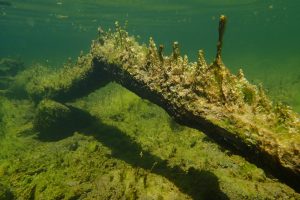Resources developed to improve management of benthic HABs

A statewide HABs (harmful algal blooms) monitoring workgroup co-led-by SCCWRP has developed a set of resources intended to help managers better protect humans and domestic animals from toxin-producing benthic blooms, which tend to form mats along the bottom of streams, lakes, and other freshwater systems.
The resources, expected to be published in April, will provide monitoring guidance, field sampling protocols, an identification guide and updated signage guidelines to support managers in tracking and responding to benthic HABs. The resources were developed by the Benthic HABs Subcommittee of the California Cyanobacterial and Harmful Algal Bloom (CCHAB) Network.
The new resources build on an initial set of signage and posting guidelines that were developed in 2020.
Unlike planktonic HABs that grow in the water column, benthic HABs have not been as extensively studied. In California, existing HAB toxin thresholds designed to protect humans and wildlife from exposure are for water-column HABs only. Meanwhile, because benthic HABs form as mats, researchers believe humans and wildlife can be exposed to benthic HABs in more uneven and unpredictable ways (i.e., when pieces of the mat suddenly break off and become suspended in the water column).
More news related to: Eutrophication, Harmful Algal Blooms